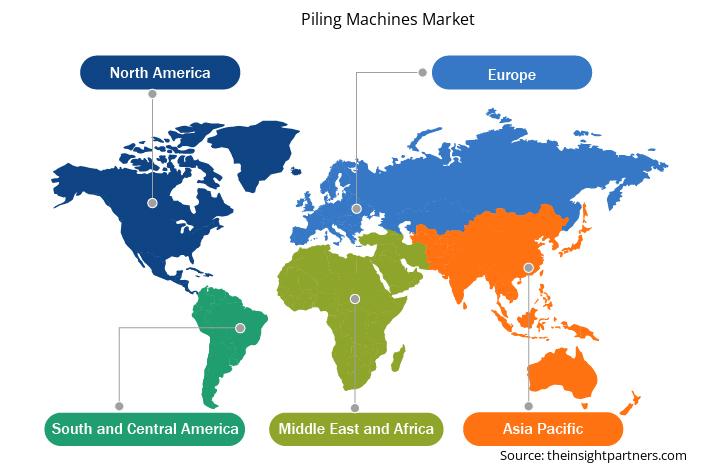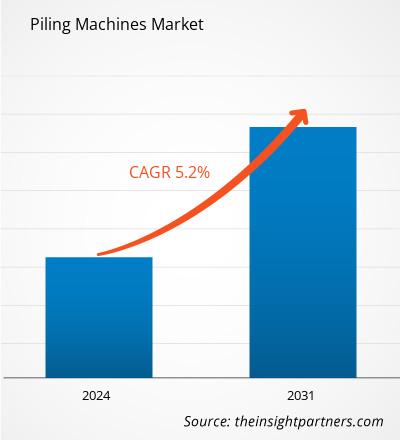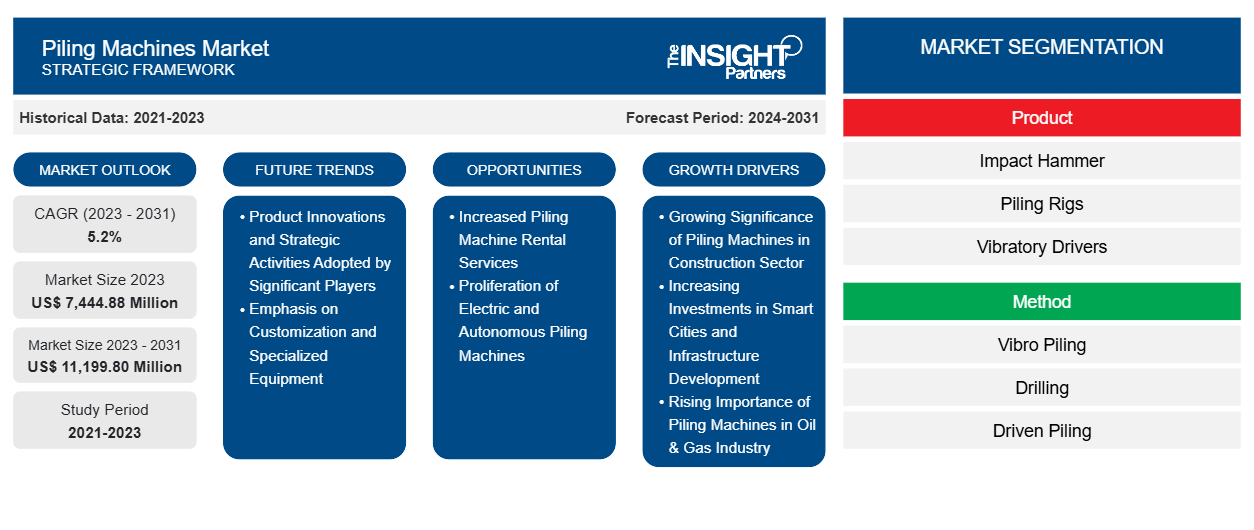Si prevede che il mercato globale delle macchine per palificazione raggiungerà 11.199,80 milioni di dollari entro il 2031, rispetto ai 7.444,88 milioni di dollari del 2023. Si prevede che il mercato registrerà un CAGR del 5,2% nel periodo 2023-2031. Gli sviluppi infrastrutturali chiave, come un numero crescente di stazioni ferroviarie, spazi commerciali, edifici, alloggi residenziali, aeroporti e impianti di trattamento delle acque, guidano la crescita del mercato delle macchine per palificazione.
Analisi del mercato globale delle macchine per palificazione
L'accettazione della perforazione si è intensificata nel corso degli anni. La distribuzione del gas ha utilizzato trivelle di medie e piccole dimensioni nel corso degli anni. Le trivelle di grandi dimensioni sono normalmente sfruttate nel settore convenzionale del petrolio e del gas. Anche il settore fognario e idrico sta guidando la crescita del mercato delle macchine per palificazione
Il settore delle costruzioni sta assistendo a un aumento degli investimenti da parte dei governi e di vari attori privati e pubblici. Canadatance, a maggio 2023, i ministeri esecutivi del governo del Saskatchewan, Canada, hanno annunciato un investimento del valore di 1,26 milioni di dollari USA in infrastrutture. A partire dal 2023, è il più grande investimento infrastrutturale nella storia del Saskatchewan. Il ministro di SaskBuilds and Procurement ha annunciato che, a parte questo, il governo del Saskatchewan sta pianificando di investire quasi 11,27 miliardi di dollari USA in infrastrutture nei prossimi quattro anni. Analogamente, a settembre 2021, il governo del Regno Unito ha annunciato 709,61 miliardi di dollari USA di investimenti privati e pubblici che dovrebbero essere implementati in progetti infrastrutturali in tutto il paese fino al 2031. Si prevede che tali crescenti investimenti guideranno il mercato delle macchine per palificazione.
Il settore delle costruzioni sta assistendo a un aumento degli investimenti da parte dei governi e di vari attori privati e pubblici. Ad esempio, a maggio 2023, i ministeri esecutivi del governo del Saskatchewan, Canada, hanno annunciato un investimento del valore di 1,26 milioni di dollari USA in infrastrutture. A partire dal 2023, si tratta del più grande investimento infrastrutturale nella storia del Saskatchewan. Il ministro per gli appalti e gli appalti del Saskatchewan ha annunciato che, a parte questo, il governo del Saskatchewan sta pianificando di investire quasi 11,27 miliardi di dollari USA in infrastrutture nei prossimi quattro anni. Analogamente, a settembre 2021, il governo del Regno Unito ha annunciato 709,61 miliardi di dollari USA di investimenti privati e pubblici che dovrebbero essere implementati in progetti infrastrutturali in tutto il paese fino al 2031. Si prevede che tali crescenti investimenti guideranno il mercato delle macchine per palificazione.
Personalizza questo report in base alle tue esigenze
Riceverai la personalizzazione gratuita di qualsiasi report, comprese parti di questo report, o analisi a livello nazionale, pacchetto dati Excel, oltre a usufruire di grandi offerte e sconti per start-up e università
-
Scopri le principali tendenze di mercato in questo rapporto.Questo campione GRATUITO includerà analisi di dati che spaziano dalle tendenze di mercato alle stime e alle previsioni.
Panoramica del mercato globale delle macchine per palificazione
L'aumento delle attività di costruzione residenziale e commerciale in tutto il mondo è uno dei fattori che guidano il mercato delle macchine per palificazione. Inoltre, la crescente spesa per le attività di ristrutturazione e ammodernamento sta influenzando positivamente la crescita del mercato delle macchine per palificazione. Ad esempio, nell'agosto 2023, T&T Construction Enterprises si è aggiudicata un contratto del valore di 3,66 milioni di dollari USA per la ristrutturazione della Hardin County Public Library, con sede negli Stati Uniti. Si prevede che tali progetti aumenteranno la domanda di macchine per palificazione durante il periodo di previsione. Inoltre, lo sviluppo del settore delle perforazioni è guidato dalla crescente applicazione di varie tecniche e attrezzature di perforazione nei settori del petrolio e del gas, dei servizi di pubblica utilità, minerario, delle telecomunicazioni e delle fognature e delle strutture idriche.
L'accettazione della perforazione si è intensificata nel corso degli anni. Nel settore della distribuzione del gas naturale, i progetti di telecomunicazione sono due notevoli aree di applicazione della perforazione, in particolare negli ambienti urbani. I progetti di telecomunicazione incrementano l'applicazione di impianti di perforazione di piccole e medie dimensioni. La distribuzione del gas ha utilizzato perforatrici di medie e piccole dimensioni nel corso degli anni. Le perforatrici di grandi dimensioni sono normalmente sfruttate nel settore convenzionale del petrolio e del gas. Anche il settore fognario e idrico sta guidando la crescita del mercato delle macchine per palificazione.
Driver e opportunità del mercato globale delle macchine per palificazione
Crescente importanza delle macchine per palificazione nel settore delle costruzioni
Il settore delle costruzioni è in continua crescita a causa di un aumento di progetti di edilizia residenziale a basso e medio prezzo, infrastrutture commerciali e iniziative infrastrutturali sostenute dal governo, tra cui strade, ponti e autostrade. Con lo sviluppo e l'evoluzione del settore delle costruzioni, la necessità di attrezzature e macchinari per l'edilizia diventa essenziale. C'è un aumento di vari tipi di progetti di sviluppo infrastrutturale, come edifici residenziali, complessi commerciali e strutture industriali. Ogni progetto necessita di vari tipi di macchinari per la costruzione, la riparazione, la manutenzione e la ristrutturazione. La rapida urbanizzazione e gli sfoghi demografici determinano la necessità di nuove abitazioni, spazi commerciali e infrastrutture. Ad esempio, a marzo 2023, il consiglio comunale canadese di Kelowna ha dichiarato l'autorizzazione al finanziamento di 90 milioni di dollari USA per il progetto di ampliamento del terminal dell'aeroporto di Kelowna.
Il crescente sviluppo delle infrastrutture in tutto il mondo guida la crescita del mercato delle Piling Machines. Ad esempio, a settembre 2024, Santo Domingo Water Utility (CAASD) ha annunciato una serie di progetti per risolvere la carenza di acqua e la mancanza di fognature nella capitale della Repubblica Dominicana, promuovendo il numero di attività di sviluppo edilizio e infrastrutturale nel paese. A gennaio 2024, l'Agenzia esecutiva europea per il clima, l'ambiente e le infrastrutture ha ricevuto circa 400 domande che richiedevano 20 miliardi di dollari USA per progetti di infrastrutture di trasporto. La popolazione in aumento è un altro fattore che aumenta la domanda di infrastrutture pubbliche e lo sviluppo di nuove reti di trasporto e strutture residenziali. Secondo i dati pubblicati dall'Unione Europea nel 2023, la popolazione dell'UE è aumentata da 446,7 milioni a gennaio 2022 a 448,4 milioni a gennaio 2023.
Aumento dei servizi di noleggio di macchine per palificazione
La crescente inclinazione verso il noleggio di attrezzature edili, comprese le macchine per palificazione, dovrebbe offrire alle aziende di noleggio un'opportunità di espandere i propri servizi. I servizi di noleggio consentono alle aziende di costruzione di accedere a macchine e attrezzature di fascia alta senza l'obbligo finanziario della proprietà. Attualmente, le macchine per palificazione non sono limitate ai progetti di costruzione convenzionali; vengono gradualmente utilizzate in vari settori, tra cui le energie rinnovabili ; ad esempio, fondamenta di turbine eoliche e costruzioni navali che coinvolgono banchine e pontili. Questa espansione apre nuove possibilità di crescita e consente ai produttori di scegliere diversi tipi di macchine per palificazione in base alle proprie esigenze. La crescente proliferazione di servizi di noleggio offre alle aziende di costruzione la libertà di noleggiare vari tipi di macchine per palificazione in base a requisiti specifici.
I servizi di noleggio offrono alle aziende l'elasticità per scalare le proprie operazioni in base alle esigenze del progetto. I progetti di costruzione variano in durata e portata, consentendo alle aziende di accedere a una flotta a noleggio per attrezzature adatte a ogni operazione senza essere vincolate a una singola macchina. Inoltre, quando si noleggiano Piling Machines, la responsabilità della manutenzione ricade normalmente sulla società di noleggio. Questa comprensione consente alle aziende di costruzione di enfatizzare le proprie attività fondamentali senza doversi preoccupare della manutenzione di macchinari pesanti
Analisi della segmentazione del rapporto sul mercato globale delle macchine per palificazione
I segmenti chiave che hanno contribuito alla derivazione dell'analisi del mercato globale delle macchine per palificazione sono prodotto, metodo e regione.
- In base al prodotto, il mercato delle macchine per palificazione è segmentato in martelli a impatto, impianti di palificazione, avvitatori vibranti e altri. In termini di metodo, il mercato è categorizzato in palificazione vibrante, perforazione e palificazione infissa. Geograficamente, il mercato è segmentato in Nord America, Europa, Asia Pacifico, Medio Oriente e Africa e Sud America.
Analisi della quota di mercato globale delle macchine per palificazione per area geografica
L'ambito geografico del rapporto sul mercato globale delle macchine per palificazione offre un'analisi regionale dettagliata.
Il settore delle costruzioni e delle infrastrutture dell'Asia Pacifica sta vivendo una solida espansione e iniziative di sviluppo, sostenute dalla crescita economica impetuosa della regione e dall'aumento della popolazione. Gli sviluppi infrastrutturali chiave includono un numero crescente di stazioni ferroviarie, spazi commerciali, edifici, alloggi residenziali, aeroporti e impianti di trattamento delle acque. I progetti ferroviari ad alta velocità sono in primo piano nell'infrastruttura dei trasporti. Il Chuo Shinkansen del Giappone, l'espansione della rete ferroviaria ad alta velocità della Cina e il collegamento Sydney-Melbourne dell'Australia sono alcuni dei principali progetti di costruzione che hanno un impatto positivo sul mercato delle macchine per palificazione.
Il governo della Nuova Zelanda sta puntando sullo sviluppo di reti infrastrutturali come sistemi idrici e fognari, reti stradali e ferroviarie, trasmissione elettrica e infrastrutture per le telecomunicazioni. La crescita della popolazione e l'urbanizzazione crescente stanno aumentando la necessità di espandere e aggiornare importanti strutture infrastrutturali nel paese. Nel 2023, il governo ha offerto circa 47 miliardi di dollari USA per lo sviluppo delle infrastrutture nei prossimi cinque anni. Si prevede che la crescente attenzione allo sviluppo delle infrastrutture spingerà la crescita delle attività di costruzione e l'applicazione di macchine per palificazione in tutto il paese nei prossimi anni.
Globale
Approfondimenti regionali sul mercato delle macchine per palificazione
Le tendenze regionali e i fattori che influenzano il mercato delle macchine per palificazione durante il periodo di previsione sono stati ampiamente spiegati dagli analisti di Insight Partners. Questa sezione discute anche i segmenti e la geografia del mercato delle macchine per palificazione in Nord America, Europa, Asia Pacifico, Medio Oriente e Africa e Sud e Centro America.

- Ottieni i dati specifici regionali per il mercato delle macchine per palificazione
Ambito del rapporto di mercato sulle macchine per palificazione
| Attributo del report | Dettagli |
|---|---|
| Dimensioni del mercato nel 2023 | 7.444,88 milioni di dollari USA |
| Dimensioni del mercato entro il 2031 | 11.199,80 milioni di dollari USA |
| CAGR globale (2023-2031) | 5,2% |
| Dati storici | 2021-2023 |
| Periodo di previsione | 2024-2031 |
| Segmenti coperti |
Per Prodotto
|
| Regioni e Paesi coperti |
America del Nord
|
| Leader di mercato e profili aziendali chiave |
|
Densità dei player del mercato delle macchine per palificazione: comprendere il suo impatto sulle dinamiche aziendali
Il mercato delle macchine per palificazione sta crescendo rapidamente, spinto dalla crescente domanda degli utenti finali dovuta a fattori quali l'evoluzione delle preferenze dei consumatori, i progressi tecnologici e una maggiore consapevolezza dei vantaggi del prodotto. Con l'aumento della domanda, le aziende stanno ampliando le loro offerte, innovando per soddisfare le esigenze dei consumatori e capitalizzando sulle tendenze emergenti, il che alimenta ulteriormente la crescita del mercato.
La densità degli operatori di mercato si riferisce alla distribuzione di aziende o società che operano in un particolare mercato o settore. Indica quanti concorrenti (operatori di mercato) sono presenti in un dato spazio di mercato in relazione alle sue dimensioni o al valore di mercato totale.
Le principali aziende che operano nel mercato delle macchine per palificazione sono:
- Azienda Liebherr Nenzing GmbH
- Società Junttan
- Azienda Bauer
- Soilmec SpA
- Casagrande SpA
- Comacchio SpA
Disclaimer : le aziende elencate sopra non sono classificate secondo un ordine particolare.

- Ottieni una panoramica dei principali attori del mercato delle macchine per palificazione
Notizie e sviluppi recenti sul mercato globale delle macchine per palificazione
Il mercato globale delle Piling Machines viene valutato raccogliendo dati qualitativi e quantitativi dopo la ricerca primaria e secondaria, che include importanti pubblicazioni aziendali, dati associativi e database. Di seguito sono elencati alcuni degli sviluppi nel mercato globale delle Piling Machines:
- Le attrezzature di perforazione e palificazione convenzionali non possono sempre essere utilizzate nel settore ferroviario senza grandi sforzi, RTG Rammtechnik GmbH, che appartiene al gruppo BAUER Maschinen, insieme alla società di Lipsia Techne e accompagnata da Hering Bau GmbH & Co. KG, ha sviluppato una perforatrice e palificazione per binari. Il sistema complessivo è costituito dal dispositivo di trasporto con una guida basata su una RTG RG 18 S, un carro pianale per lo stoccaggio della guida e un altro carro pianale per il trasporto e per l'aggiornamento degli accessori. Con la guida eretta, il dispositivo raggiunge un'altezza di circa 23 m. La guida ha un argano principale da 170 kN, un argano di alimentazione da 200 kN e un argano ausiliario da 55 kN. Durante il funzionamento è possibile un'inclinazione dell'albero di 5° in tutte le direzioni per compensare la formazione. Inoltre, la guida può essere ruotata attorno all'asse del braccio telescopico di 90° su ciascun lato, il che significa che può sempre essere portata nella posizione di lavoro desiderata in relazione alla sovrastruttura. Il braccio guida può essere telescopico fino a 2 m. Il collegamento è imbullonato idraulicamente.
- Bauma, la fiera leader mondiale per macchinari edili, macchine per materiali edili, macchine per l'industria mineraria, veicoli edili e attrezzature edili, apre le sue porte al centro espositivo di Monaco di Baviera. Oltre 3.000 espositori da 58 paesi si presenteranno su circa 200.000 m 2 di superficie lorda e oltre 400.000 m 2 di superficie esterna fino al 30 ottobre.
- BAUER Training Center GmbH, insieme a Usaneers GmbH, ha sviluppato l'applicazione "Next Level Operator". Per il settore edile sono disponibili due opzioni di formazione. Gli unici requisiti sono una connessione Internet stabile e occhiali per realtà aumentata (AR glasses) con il software appropriato.
Copertura e risultati del rapporto sul mercato globale delle macchine per palificazione
Il rapporto "Dimensioni e previsioni del mercato globale delle macchine per palificazione (2021-2031)" fornisce un'analisi dettagliata del mercato che copre le seguenti aree:
- Dimensioni e previsioni del mercato globale delle macchine per palificazione a livello regionale e nazionale per tutti i segmenti di mercato chiave coperti dall'ambito
- Tendenze del mercato globale delle macchine per palificazione, nonché dinamiche di mercato come driver, vincoli e opportunità chiave
- Analisi PEST e SWOT dettagliate
- Analisi del mercato globale delle macchine per palificazione che copre le principali tendenze del mercato, il quadro globale e regionale, i principali attori, le normative e i recenti sviluppi del mercato
- Analisi del panorama industriale e della concorrenza che copre la concentrazione del mercato, l'analisi della mappa di calore, i principali attori e gli sviluppi recenti per il mercato globale delle macchine per palificazione
- Profili aziendali dettagliati
- Analisi storica (2 anni), anno base, previsione (7 anni) con CAGR
- Analisi PEST e SWOT
- Valore/volume delle dimensioni del mercato - Globale, Regionale, Nazionale
- Industria e panorama competitivo
- Set di dati Excel
Report recenti
Testimonianze
Motivo dell'acquisto
- Processo decisionale informato
- Comprensione delle dinamiche di mercato
- Analisi competitiva
- Analisi dei clienti
- Previsioni di mercato
- Mitigazione del rischio
- Pianificazione strategica
- Giustificazione degli investimenti
- Identificazione dei mercati emergenti
- Miglioramento delle strategie di marketing
- Aumento dell'efficienza operativa
- Allineamento alle tendenze normative























 Ottieni un campione gratuito per - Mercato delle macchine per palificazione
Ottieni un campione gratuito per - Mercato delle macchine per palificazione